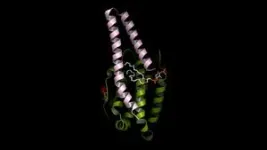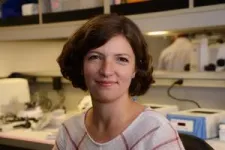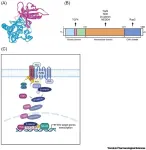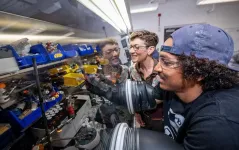(Press-News.org) Within the family of cell membrane lipids known as phosphoinositides and the kinase enzymes that regulate them, phosphoinositide 3-kinases (PI3Ks) have been cast in a starring role as scientists study their involvement in cancer, diabetes and many cellular activities.
The presence of PI3Ks in the scientific limelight has overshadowed other members of this lipid enzyme family, including phosphatidylinositol-5-phosphate 4-kinases (PI5P4Ks). Brooke Emerling, Ph.D., co-director of, and associate professor in, the Cancer Metabolism and Microenvironment Program at Sanford Burnham Prebys, is contributing to a revival of interest in this underappreciated set of enzymes.
Emerling and team have now shown for the first time that PI5P4K activity is connected to the regulation of an ancient signaling system called the hippo pathway, which is found in a wide variety of organisms and is known to help human organs grow and control their size. In a study published in Science Signaling, Emerling and co-senior author Raymond Blind, Ph.D., at Vanderbilt University Medical Center, shared their findings, which open new research avenues to tackle aggressive cancers.
“Up till now, my lab has focused on what these enzymes are, why PI5P4Ks are important and how they affect tumor growth,” says Emerling. “Because of the potential to target these enzymes with new drugs to treat cancer, it is important to know more about what they do and how they are regulated.”
Since only a few PI5P4K regulators were known, the research team screened 29 other potential regulators and found two—core components of the hippo pathway called MST1 and MST2—that were the most effective at blocking PI5P4K activity.
“These results are exciting because the hippo pathway is a major pathway that’s dysregulated in cancer,” notes Emerling. “The field has found it very difficult to develop drugs that directly target the hippo pathway, so this result piqued our interest, as we may be able to target PI5P4Ks to get to cancers with abnormal hippo signaling.”
Additional studies with genetically engineered cells revealed that PI5P4K activity was elevated in the absence of MST1 and MST2, suggesting that these two enzyme kinases might “control” PI5P4K.
“Our hypothesis is that MST1 and MST2 keep PI5P4Ks in check,” says Emerling. “So when you lose MST activity in cancer cells, they can keep turning on PI5P4K, and then you get more aggressive metastatic tumors.”
The researchers also looked at how PI5P4K activity influenced other components of the hippo pathway and found that reduced PI5P4K activity was linked to decreased activity in the Yes-associated protein (YAP), which sits at the end of the hippo pathway—and is directly linked to cancer.
“YAP is often used in the clinic as a biomarker for aggressive tumors, and it’s really easy to stain for YAP in patient biopsies,” says Emerling. “Researchers have been trying to make drugs that target YAP, and now we see a lot of potential in trying to instead inhibit PI5P4K as a possible treatment for cancers that have YAP activation. Several compounds have already been developed to inhibit PI5P4K and could be used in future studies to explore this approach.”
To follow up on this newly published research, the team plans to use structural biology to better understand exactly how the lipids and proteins interact at the intersection of the PI5P4K and hippo pathways. The scientists also plan to conduct preclinical studies to see if they can inhibit PI5P4K in mouse tumor models, measure the effects on YAP activity and determine if this might eventually benefit cancer patients in the future.
The study builds on Emerling’s previous work published in Science Advances that described how prostate cancer cells can be killed by targeting one of the PI5P4Ks called PI5P4Kα.
“This work has a great potential to help people, and we’re dedicated to advancing this research so we can make that happen,” adds Emerling.
Additional authors on the study include Lavinia Palamiuc, Ryan M. Loughran, Gurpreet K. Arora, Vivian Tieu, Kyanh Ly, Alicia Llorente, Sophia Crabtree, Archna Ravi and Rabi Murad—all at Sanford Burnham Prebys; Jared L. Johnson and Jenny C. Y. Wong from Weill Cornell Medicine; Zeinab Haratipour and Woong Jae Choi from Vanderbilt University Medical Center; and Thorsten Wiederhold from Cell Signaling Technology, Inc.
The study was supported by the National Cancer Institute (R01 CA237536, T32 CA211036 and R21 CA243036), the National Institute of General Medical Sciences (R01 GM143583 and R01 GM132592), the National Institute of Diabetes and Digestive and Kidney Diseases (T32 DK007673), the National Human Genome Research Institute (T32 HG008341), the American Cancer Society (RSG-20-064-01-TBE, TLC-21-156-01 and RSG-17-063-01), and the V Foundation for Cancer Research (V2016-015).
The study’s DOI is 10.1126/scisignal.ado6266.
END
Overlooked lipid connected to ancient cellular pathway with links to cancer
Scientists at Sanford Burnham Prebys and Vanderbilt University uncover a new role for a neglected lipid that may play a role in aggressive cancers
2024-05-28
ELSE PRESS RELEASES FROM THIS DATE:
Text reminders help connect health care workers to care and improve their mental health
2024-05-28
Health care workers have reported spikes in feeling burnt out in the time since the COVID-19 pandemic began, with nearly half saying it took a toll in 2022 compared to 32 percent in 2018. But a new study shows that easy-to-use and accessible platforms may help reverse this trend. Regular, automated text message reminders connecting staff to a mental health platform called “Cobalt,” drove significant improvements in both depression and anxiety scores among employees, according to a new JAMA Network Open study from the Perelman School of Medicine at the University of Pennsylvania.
“What we found shows ...
Optimal cancer-killing t cells discovered
2024-05-28
A team of cancer researchers, led by the University of Houston, has discovered a new subset of T cells that may improve the outcome for patients treated with T-cell therapies.
T cell-based immunotherapy has tremendous value to fight, and often eliminate, cancer. The strategy activates a patient’s immune system and engineers a patient’s own T cells to recognize, attack and kill cancer cells. In this way, the body’s own T cells become living drugs.
While T-cell immunotherapy has revolutionized cancer treatment, there is still much to learn. Unfortunately, not all patients ...
Wind farms are cheaper than you think – and could have prevented Fukushima, says global review
2024-05-28
Offshore wind could have prevented the Fukushima disaster, according to a review of wind energy led by the University of Surrey.
The researchers found that offshore turbines could have averted the 2011 nuclear disaster in Japan by keeping the cooling systems running and avoiding meltdown. The team also found that wind farms are not as vulnerable to earthquakes.
Suby Bhattacharya, Professor of Geomechanics at the University of Surrey’s Department of Civil and Environmental Engineering, said:
“Wind power gives us plentiful clean energy – now we know that it could also make other facilities safer and more reliable. The global review finds ...
Improved refrigeration could save nearly half of the 1.3 billion tons of food wasted each year globally
2024-05-28
May 28, 2024
Contact: Jim Erickson, 734-647-1842, ericksn@umich.edu
Graphic
Improved refrigeration could save nearly half of the 1.3 billion tons of food wasted each year globally
ANN ARBOR—About a third of the food produced globally each year goes to waste, while approximately 800 million people suffer from hunger, according to the U.N.'s Food and Agriculture Organization.
A new University of Michigan study concludes that nearly half of the food waste, about 620 million metric tons, could be eliminated by fully refrigerated food supply chains worldwide.
At the same time, ...
From fibrosis and cancer to obesity, Alzheimer’s and aging: New paper reveals broad potential of TNIK as a therapeutic target
2024-05-28
A new paper in Trends in Pharmacological Sciences from researchers at generative artificial intelligence (AI)- and robotics-powered clinical stage drug discovery company Insilico Medicine (“Insilico”) and ETH Zurich reveals the broad potential of TNIK as a therapeutic target for some of the most pervasive aging-related diseases, including fibrosis, cancer, obesity, and Alzheimer’s. The findings could guide the development of new therapeutics. The lead drug in Insilico’s pipeline, INS018_055, is an AI-designed TNIK inhibitor being advanced as a treatment ...
Finnish Vole fever spreading further south
2024-05-28
Researchers have discovered that bank voles in southern Sweden (Skåne) carry a virus that can cause hemorrhagic fever in humans. This finding was made more than 500 km south of the previously known range. The virus strain discovered in Skåne appears to be more closely related to strains from Finland and Karelia than to the variants found in northern Sweden and Denmark. This is revealed in a new study from Uppsala University, conducted in collaboration with infectious diseases doctors in Kristianstad and published ...
Prenatal exposure to air pollution associated with increased mental health risks
2024-05-28
A baby’s exposure to air pollution while in the womb is associated with the development of certain mental health problems once the infant reaches adolescence, new research has found. The University of Bristol-led study, published in JAMA Network Open today [28 May], examined the long-term mental health impact of early-life exposure to air and noise pollution.
Growing evidence suggests air pollution, which comprises toxic gases and particulate matter, might contribute to the onset of mental health problems. It is thought that pollution could negatively affect mental health via numerous ...
New research supports expansion of kidney donation to include organs from deceased patients who once had dialysis
2024-05-28
Researchers from Johns Hopkins Medicine propose a novel approach to addressing the pressing issue of a kidney donor shortage through findings that suggest a promising method to expand the pool of available kidney donors by utilizing deceased donors on dialysis for kidney transplants.
The findings, published in the May 23rd issue of JAMA, identifies that while those who received such kidneys experienced a “significant delay” in the function of the transplanted organ compared to those ...
A cleaner way to produce ammonia
2024-05-28
– By Rachel Berkowitz
Ammonia is the starting point for the fertilizers that have secured the world’s food supply for the last century. It’s also a main component of cleaning products, and is even considered as a future carbon-free replacement for fossil fuels in vehicles. But synthesizing ammonia from molecular nitrogen is an energy-intensive industrial process, due to the high temperatures and pressures at which the standard reaction proceeds. Scientists from the Department of Energy's Lawrence Berkeley ...
How killifish embryos use suspended animation to survive over 8 months of drought
2024-05-28
The African turquoise killifish lives in ephemeral ponds in Zimbabwe and Mozambique. To survive the annual dry season, the fish’s embryos enter a state of extreme suspended animation or “diapause” for approximately 8 months. Now, researchers have uncovered the mechanisms that enabled the killifish to evolve this extreme survival state. They report May 30 in the journal Cell that although killifish evolved diapause less than 18 million years ago, they did so by co-opting ancient genes ...
LAST 30 PRESS RELEASES:
When is it time to jump? The boiling frog problem of AI use in physics education
Twitter data reveals partisan divide in understanding why pollen season's getting worse
AI is quick but risky for updating old software
Revolutionizing biosecurity: new multi-omics framework to transform invasive species management
From ancient herb to modern medicine: new review unveils the multi-targeted healing potential of Borago officinalis
Building a global scientific community: Biological Diversity Journal announces dual recruitment of Editorial Board and Youth Editorial Board members
Microbes that break down antibiotics help protect ecosystems under drug pollution
Smart biochar that remembers pollutants offers a new way to clean water and recycle biomass
Rice genes matter more than domestication in shaping plant microbiomes
Ticking time bomb: Some farmers report as many as 70 tick encounters over a 6-month period
Turning garden and crop waste into plastics
Scientists discover ‘platypus galaxies’ in the early universe
Seeing thyroid cancer in a new light: when AI meets label-free imaging in the operating room
Neutrophil-to-lymphocyte ratio may aid risk stratification in depressive disorder
2026 Seismological Society of America Annual Meeting
AI-powered ECG analysis offers promising path for early detection of chronic obstructive pulmonary disease, says Mount Sinai researchers
GIMM uncovers flaws in lab-grown heart cells and paves the way for improved treatments
Cracking the evolutionary code of sleep
Medications could help the aging brain cope with surgery, memory impairment
Back pain linked to worse sleep years later in men over 65, according to study
CDC urges ‘shared decision-making’ on some childhood vaccines; many unclear about what that means
New research finds that an ‘equal treatment’ approach to economic opportunity advertising can backfire
Researchers create shape-shifting, self-navigating microparticles
Science army mobilizes to map US soil microbiome
Researchers develop new tools to turn grain crops into biosensors
Do supervised consumption sites bring increased crime? Study suggests that’s a myth
New mass spec innovation could transform research
Maternal nativity, race, and ethnicity and infant mortality in the US
Migration-related trauma among asylum seekers exposed to the migrant protection protocols
Jupiter’s moon Europa has a seafloor that may be quiet and lifeless
[Press-News.org] Overlooked lipid connected to ancient cellular pathway with links to cancerScientists at Sanford Burnham Prebys and Vanderbilt University uncover a new role for a neglected lipid that may play a role in aggressive cancers







